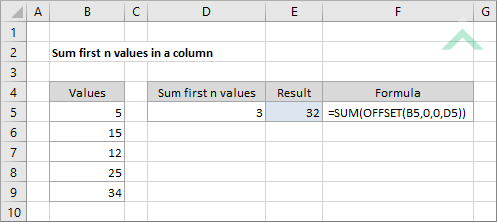Sum first n values in a column
To sum the first n values in a column you can use a combination of Excel SUM and OFFSET functions, using Excel and VBA
Example: Sum first n values in a column

|
=SUM(OFFSET(B5,0,0,D5))
|
This formula sums the first n values from a specific column, using a combination of the Excel SUM and OFFSET functions. In this example the formula sums the first three values (the number is captured in cell D5 and referenced in the formula) in column B.
Please note that if there is a blank cell or a non numeric value in the column the formula will take this cell into consideration and will apply a value of 0 against the cell. |
Sub Sum_first_n_values_in_a_column()
'declare a variable
Dim ws As Worksheet
Dim ws As Worksheet
Set ws = Worksheets("Analysis")
'sum the first three values in a column
ws.Range("E3") = Application.Sum(Range("B5").Offset(0, 0).Resize(Range("D5")))
ws.Range("E3") = Application.Sum(Range("B5").Offset(0, 0).Resize(Range("D5")))
End Sub
PREREQUISITES
Worksheet Name: Have a worksheet named Analysis.
First cell in range: If using the exact same VBA code, the first cell in a range needs to be ("B5").
First n values: In this example we are referencing to a cell ("D5") that contains a number of the first n values to sum. Therefore, if using the exact same VBA code you will need to capture a number of the first n values in cell ("D5").
Worksheet Name: Have a worksheet named Analysis.
First cell in range: If using the exact same VBA code, the first cell in a range needs to be ("B5").
First n values: In this example we are referencing to a cell ("D5") that contains a number of the first n values to sum. Therefore, if using the exact same VBA code you will need to capture a number of the first n values in cell ("D5").
ADJUSTABLE PARAMETERS
Output Range: Select the output range by changing the cell references ("E5") in the VBA code to any cell in the worksheet, that doesn't conflict with the formula.
First cell in range: Select the first cell in a range (column) from which to sum the first n values by changing the cell reference ("B5") in the VBA code to any cell that doesn't conflict with the formula.
First n values: Select the first number of values that you want to sum in the specified column by changing the cell reference ("D5") in the VBA code to any cell that contains the number and doesn't conflict with the formula. You can also enter the number directly in the VBA code, by replacing 'Range("D5")' with a number.
Output Range: Select the output range by changing the cell references ("E5") in the VBA code to any cell in the worksheet, that doesn't conflict with the formula.
First cell in range: Select the first cell in a range (column) from which to sum the first n values by changing the cell reference ("B5") in the VBA code to any cell that doesn't conflict with the formula.
First n values: Select the first number of values that you want to sum in the specified column by changing the cell reference ("D5") in the VBA code to any cell that contains the number and doesn't conflict with the formula. You can also enter the number directly in the VBA code, by replacing 'Range("D5")' with a number.
EXPLANATION
This tutorial shows and explains how to sum first n values in a column, by using an Excel formula or VBA.
This tutorial shows and explains how to sum first n values in a column, by using an Excel formula or VBA.
Excel Method: This tutorial provides a single Excel method that can be applied to sum first n values in a column, using a combination of Excel SUM and OFFSET functions.
VBA Methods: This tutorial provides a single VBA method that sums the first n values in a column by applying the SUM and OFFSET functions in the VBA code.
FORMULA
SUM(OFFSET(first_cell,0,0,first_n_values))
SUM(OFFSET(first_cell,0,0,first_n_values))
ARGUMENTS
first_cell: The first cell in a specific column from which to begin summing the first n values.
first_n_values: A number that represents the first n values to be summed.
first_cell: The first cell in a specific column from which to begin summing the first n values.
first_n_values: A number that represents the first n values to be summed.
ADDITIONAL NOTES
Note 1: If a blank cell or a non-numeric value is captured in the first n values to be summed, the formula treats these the same as 0.
Note 1: If a blank cell or a non-numeric value is captured in the first n values to be summed, the formula treats these the same as 0.
RELATED TOPICS
| Related Topic | Description | Related Topic and Description |
|---|---|---|
| Sum largest n numbers | How to sum the largest n numbers in a range using Excel and VBA methods | |
| Sum smallest n numbers | How to sum the smallest n numbers in a range using Excel and VBA methods | |
| Sum cells with values in odd columns | How to sum cells with values in odd columns using Excel and VBA methods | |
| Sum cells with values in even columns | How to sum cells with values in even columns using Excel and VBA methods | |
| Sum first n values in a row | How to sum the first n values in a row using Excel and VBA methods |
RELATED FUNCTIONS
| Related Functions | Description | Related Functions and Description |
|---|---|---|
| SUM Function | The Excel SUM function returns the sum of all numbers in a specified range |
